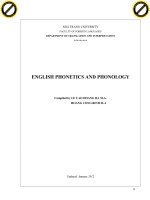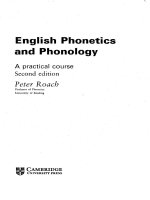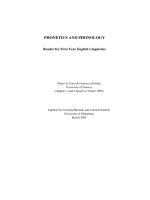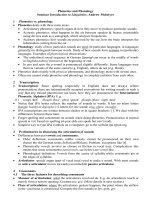Phonetics and Phonology 2023
Bạn đang xem bản rút gọn của tài liệu. Xem và tải ngay bản đầy đủ của tài liệu tại đây (2.71 MB, 88 trang )
Selected and Compiled
English
Phonetics and Phonology
March, 2023
For Internal Use Only
1
2
Contents
Chapter 1: The Production of Speech
A. The Larynx
B. The Articulators above the Larynx
Chapter 2: English Vowel Sounds
A.
B.
C.
D.
E.
Vowel Sounds
Vowel Classification
Monophthongs
Diphthongs
Triphthongs
Exercises
Chapter 3: English Consonant Sounds
A.
B.
C.
D.
E.
F.
G.
H.
1
1
3
6
6
6
9
11
13
14
17
Consonant Sounds
Consonant Classification
The Plosive Consonants
The Fricative Consonants
The Affricate Consonants
The Nasal Consonants
The Lateral Consonants
The Approximant Consonants
Exercises
17
17
20
23
25
25
27
27
30
Chapter 4: Phonetics and Phonology Basic Terminology
34
A. Phoneme vs. Allophone
B. Phonetic vs. Phonemic Transcription
Exercises
Chapter 5: The Syllable
A. The Nature of the Syllable
B. The Structure of English Syllable
34
35
37
38
38
38
Chapter 6: Strong and Weak Syllables
A.
B.
C.
D.
Strong and Weak Syllables
The Vowel /ə/
[i] and [u] as a result of neutralization
Syllabic consonants
Exercises
Chapter 7: Stress
A. The Nature of Stress
B. Level of Stress
C. The Placement of Stress
Exercises
40
40
40
41
41
44
45
45
45
46
54
Chapter 8: Weak Forms
55
Chapter 9: Aspects of Connected Speech
61
A. Rhythm
B. Assimilation
61
62
Chapter 10: Intonation 1
71
Chapter 11: Intonation 2
72
A. The Tone Unit
B. Pitch Possibilities in the Simple Tone-unit
C. Pitch Possibilities in the Complex Tone-unit
Chapter 12: Functions of Intonation
A.
B.
C.
D.
E.
Attitudinal Function of Intonation
Accentual Function of Intonation
Grammatical Function of Intonation
Discourse Function of Intonation
Regulation of Conversational Behavior
72
73
74
77
77
78
78
79
79
Chapter
1
English Phonetics and Phonology
The Production of Sounds
A The Larynx
To speak we need air, which is pushed out of our lungs. Different sounds are made by
obstructing this airstream in different ways. We use our vocal organs to make these
obstructions. The airstream from our lungs moves up first through the windpipe and next
through the larynx.
Figure 1: Major anatomical structures involved in the production of speech sounds
The larynxis a box-like structure made of muscle and cartilage1 and is situated at the upper end
of the windpipe. At the front of the neck, the larynx comes to a point known as the Adam’s
Apple.
1
cartilage: is a soft kind of bone
Chapter 1:The Production of Speech Sounds1
Thyroid cartilage
Cricoid cartilage
Tracheal rings
Figure 2: The larynx
Inside the larynx are the vocal folds2, two bands of muscular tissue that stretch from the front
to the back within the larynx.
Arytenoid cartilages
Figure 3: The inside of the larynx seen from above
At the back of the larynx the vocal folds are attached to a pair of small cartilages. When these
cartilages move, the vocal folds move with them and so the opening between the two vocal
folds, called the glottis, with vary accordingly.
Figure 4: Arytenoid cartilages causing closing and opening of the glottis
2
vocal folds: “vocal cords” (an older name for vocal folds)
Chapter 1:The Production of Speech Sounds2
There are four basic states of the vocal folds that are important for speech:
Wide apart: The airstream is not obstructed by the vocal folds, so it
passes freely through the glottis. Voiceless consonants are made
with the vocal folds wide apart.
wide apart
Narrow glottis: The air escapes through the narrow glottis with
some difficulty and you hear the friction of the air against the vocal
folds. The result is the sound /h/.
narrow glottis
touchedor
nearly touched
Position for vocal fold vibration: When the edges of the vocal
folds are touching each other, or nearly touching, air passing
through the glottis will usually cause vibration. Air is pressed up
from the lungs and this air pushes the vocal folds apart so that a
little air escapes. As the air flows quickly past the edges of the
vocal folds, the folds are brought back together again. This opening
and closing happens very rapidly and is repeated regularly. The
result is voiced sounds, i.e. vowels and voiced consonants.
Vocal folds tightly closed: The vocal folds are firmly pressed
together and air cannot escape between them. The speech sound
which is made like this is called a glottal plosive /ʔ/.
tightly closed
B The Articulators above the Larynx
Once the air has passed through the glottis, it continues through the vocal tract. The vocal tract
is the whole of the air passage above the larynx; viz the pharynx, the oral cavity and the nasal
cavity. The oral cavity is the air passage within the mouth. The air passage within the nose is
called the nasal cavity. What sound is made depends not only on the state of the vocal folds,
Chapter 1:The Production of Speech Sounds3
but also on the shape of the vocal tract. The shape of the vocal tract can be altered by changing
the shape and position of your articulators.
The Articulators are the vocal organs which are involved in the production of sounds.
Figure 5: Articulators above the larynx
The following are the articulators situated above the larynx.
The pharynx: is a tube which begins just above the larynx and at the top, it is divided
into two parts: one part is at the back of the mouth and the other is the beginning of the
way through the nasal cavity.
The lips:bilabial consonants are made when the lips are in contact with each other,
while those with lip-to-teeth contact are labiodental consonants. The shape of the lips is
also important in the production of vowels.
The teeth: Dental sounds are produced with the tongue touch the front teeth.
The tongue:modifies the shape of the oral cavity by moving into different places and
assuming different shapes. It can be divided into 6 different parts: tip, blade, front,
center, back and root.
Figure 6: Parts of the tongue
Chapter 1:The Production of Speech Sounds4
The alveolar ridge:is situated between the top front teeth and the hard palate. Alveolar
consonants are made with the tongue touching or approaching the alveolar ridge.
The hard palate:is the arched bony area immediately behind the alveolar ridge. It is
often called the “roof” of the mouth. When the front upper surface of the lounge
(nearly) touches the hard palate palatal consonants result.
The soft palate (= the velum):is the muscular flap at the back of the mouth behind the
hard palate. It is raised for the production of all oral sounds, closing the upper part of
the pharynx and thus preventing air from moving through the nasal cavity. For the
articulation of nasal sounds, air escapes through the nose the velum is lowered to keep
the air passage to the nose open. Velar consonants are made when the back of the
tongue touches the velum.
velum
lowered
velum
raised
Figure 7: The two basic positions of the velum.
Chapter 1:The Production of Speech Sounds5
Chapter
2
English Vowel Sounds
A Vowel Sounds
We can define speech sounds in two ways. The phonetic definitionclassifies speech sounds by
the way we produce them. The phonological definitionconsiders their distribution, i.e. in what
positions in a word they can occur, and their context next to what other sounds they occur.
Vowels
Phonetic characteristics
Vocal fold vibration
Absence of obstruction in the
vocal tract (the air flows freely)
Phonological characteristics
Occurs at the center of syllable – a
group of phonemes that are
pronounced together
English vowels are also divided into three types depending on the number of vowel sounds they
consist of:
Monophthongs are single vowel sounds that may be long and short.
Diphthongsare double vowel sounds formed by gliding (moving) from one vowel
position to another.
Triphthongs are triple vowel sounds made by gliding from one vowel position to a
second and then to a third.
B Vowel Classification
The quality of a vowel depends on the tongue height,tongue shape, and the lip shape.
1. Tongue height:
Tongue height is the vertical
distance between the upper surface
of the tongue and the palate.
Chapter 2:English Vowel Sounds6
Close vowel: if the distance
between the surface of the
tongue and the roof of the
mouth is small
Open vowel:if the distance
between the surface of the
tongue and the roof of the
mouth is big
Figure 1 shows that the tongue in the articulation of the vowel /i:/ is high in the mouth – it is a
close vowel – and that for /æ/ there is a big space between the surface of the tongue and the
roof of the mouth so /æ/ is an open vowel. Some vowels are neither close nor open, they are
mid-vowels like /e/.
Figure 9: Tongue height for the vowels /i:/ and /æ/
2. Tongue shape
The tongue shape depends on which
part of the tongue, between front
and back is raised highest.
Chapter 2:English Vowel Sounds7
/i:/(a front vowel) the front part of
the tongue is raised the highest
/ə/: (a central vowel)
neither front nor back
/u:/(a back vowel) the back of the
tongue is raised the highest
3. Lip shape
Unrounded (spread):
When the lips are
spread, the corners are
moved away from each
other (/i:/)
Rounded: the corners of the
lips are brought towards
each other and the lips are
pushed forwards (/u:/)
Neutral: the lips are neither
rounded nor spread(/ə/)
Lip shape: Vowel quality also varies depending on whether the lips are
rounded, spread or in a neutral position
Chapter 2:English Vowel Sounds8
Central vowels: between the tongue
front and back is raised highest
Back vowels: the tongue
back is raised highest
Close vowels:little space
between the surface of
the tongue and the roof of
the mouth.
Mid-vowels:neither open
nor close.
Front vowels: the tongue
front is raised highest
Open vowels:much space
between the surface of
the tongue and the roof of
the mouth.
C Monophthongs
Monophthongs are single vowel sounds that may be long and short.
The English short vowels are: /ɪ/, /e/, /æ/, /ʌ/, /ə/, /ɒ/, /ʊ/
The long vowels are: /i:/, /ɜ:/, /u:/, /ɑ:/, /ɔː/.
The precise length of English vowels varies depending on:
Context: For instance, when a vowel is followed by a voiceless consonant, it is shorter
than when it stands before a voiced consonant. (e.g. beat, bit, bet all have shorter
vowels than bead, bid, bed).
Stress: When a vowel occurs in an unstressed syllable, it is shorter than when it is in a
stressed syllable. Compare record (v) /rɪˈkɔːd/ and record (n) /ˈrekɔːd/. The long vowel in
the noun is not as long as the on the one in the verb.
Chapter 2:English Vowel Sounds9
To produce a correct short vowel, it is not enough to simply cut
the long vowel short. Long vowels differ from short ones not only
in quantity (length) but also in quality (they sound different).
You can see this difference in the vowel quadrilateral.
close; back; more open and less
back than /u:/; rounded lips
close; front; more close and
front than /ɪ/; spread lips
close; front; less front and more
open than /i:/, slightly spread lips
close; back; slightly rounded
lips
mid; central; neutral lip
position. this vowel has a
name “schwa”
mid; back; much
more close than /ɒ/;
strong lip-rounding
mid; front; more open
than /ɪ/; slightly spread
lips
mid; central; neutral
lip position
open; central; more
open and slightly more
front than /ə/; neutral
lip position
open; back; slightly
rounded lips
open, front, /æ/ is much
more open than /e/; much
more front than /ɑ:/;
slightly spread lips
DVD
Sounds
/i:/
/ɪ/
/e/
/æ/
/ʌ/
/ə/
Examples
beat, heel, leave
bit, hill, live
bet, pen, dead
bat, pan, dad
but, some, rush
about, printer, tomorrow
Sounds
/ɜ:/
/ʊ/
/u:/
/ɒ/
/ɔː/
/ɑ:/
open; back; much more back and lightly
more open than /æ/; neutral lip position
Examples
fir, curse, learn
pull, could, foot
pool, cooed, food
pot, shot, spot
port, short, sport
part, half, father
Chapter 2:English Vowel Sounds10
Characteristics of Vowels
The following characteristics of vowel sounds are necessary for clear articulation.
The tongue, lower jaw, and lips are important in vowel articulation.
The tip of the tongue is placed behind the lower teeth for all vowel sounds.
The front of the tongue humps or bunches toward the front palate for the front
vowels
The center of the tongue humps or bunches toward the center palate for the
central vowels.
The back of the tongue humps or bunches toward the soft palate for the back
vowels.
High vowels are articulated with the jaws close together.
Mid vowels are articulated with the tongue and jaw lower.
Lower vowels are made with the tongue and jaw lowest of all.
The lips are more spread in the high front vowels than in the low front vowels.
The lips are more rounded in high back vowels than in low back vowels.
The soft palate is raised for all vowels.
D Diphthongs
A diphthong consists of two vowel sounds; it consists of a glide from one vowel to a another.
DVD
Sounds
/ɪə/
/eə/
/ʊə/
/eɪ/
/aɪ/3
/ɔɪ/
/əʊ/
/aʊ/
3
Examples
hear, peer, queer, near, beer
hair, pair, stare, where, bear
poor, lure, moor, moored
stay, taste, faint, name
stay, height, tight, climb, fine
coy, host, coin, spoil, joy
code, host, no, row, boast
cow, house, now, loud, row
You may see this diphthong written an /ʌɪ/ symbol which is more a modern version of RP
Chapter 2:English Vowel Sounds11
Diphthongs can be classified according to the movement that is made in going from the first to
the second element: if the second element is closer than the first, then a closing glide is made;
if the second element is more central then a centering movement happens.
Figure 12: The classification of diphthongs
Pronunciation note
A diphthong begins in one vowel and moves in the direction of another vowel. The quality of
the vowel sounds which make up diphthongs is not usually exactly the same as that of a similar
long or short vowel. For example, the starting point for /aɪ/ is an open vowel which is more
back than /æ/ and more front than /ɑ:/. From this starting point the tongue moves towards the
position for /ɪ/ but does not really reach its destination. Figure 13 illustrates the diphthongs
glides.
Figure 13: The gliding movements of the English diphthongs
Furthermore, the first partof a diphthong is normally louder and longer than the second, which
is short and quieter. Nevertheless, diphthongs are not pronounced as monophthongs. Made is
/meɪd/, not /med/.
Chapter 2:English Vowel Sounds12
Some learners of English have a tendency to mispronounce /eɪ/ as /æɪ/ (a non-existing
diphthong in RP). Thus, a word like eight is mispronounced /æɪt/ instead of /eɪt/. while this is
perfectly natural for speakers of, for example, the London dialect of British English, it is not
correct in standard pronunciation.
E Triphthongs
Triphthongs glide rapidly from one vowel to another and then to a third.
Sounds
/eɪə/
/aɪə/
/ɔɪə/
/əʊə/
/aʊə/
Examples
layer, player
liar, fire, wire, choir
loyal, royal
lower, mower
hour, power, sour, flower
Pronunciation Note
In present-day English, the middle of the three vowels can hardly be heard and the resulting
sounds are sometimes difficult to distinguish from diphthongs or long vowels. For example,
many speakers say /aə/ instead of /aʊə/(hour), or /eə/ instead of /eɪə/(layer).
Chapter 2:English Vowel Sounds13
Chapter 2: Exercises
NOTE:the phonemic transcriptions are for Standard British English. Also, it must be kept in mind
that quite a few words have more than one possible correct pronunciation. Bear this in mind
while consulting a dictionary.
2.1
In each of the following word pairs, underline the word which has the closer vowel.
a)
b)
c)
d)
hot food
red book
green grass
six men
a)
b)
c)
d)
Underline the vowels which contain a rounded vowel.
/mu:n/
e) /kʊd/
/kɔ:t/
f) /krʌm/
/hi:p/
g) /ʃʌv/
/glɑ:s/
h) /ˈpiːpl/
2.2
2.3
e)
f)
g)
h)
four feet
first scheme
her arm
see red
i) felt hat
j) damp mist
i) /wɜ:d/
j) /hɑ:t/
Write the phonemic symbols that correspond to each of the following descriptions.
E.g. long close front spread vowel /i:/
a)
b)
c)
d)
e)
f)
2.4
short open front spread vowel
short close front spread vowel
long close back rounded vowel
long mid central neutral vowel
long open back neutral vowel
short open back rounded vowel
Describe the vowels below using articulatory features.
a) /ʊ/
b) /ɔ:/
2.5
c) /ə/
d) /e/
Next to each word, write the phonemic symbol for the vowel it contains.
Chapter 2:English Vowel Sounds14
a)
b)
c)
d)
2.6
lease
draught
pod
muse
e)
f)
g)
h)
than
cheque
laughter
tomb
i)
j)
k)
l)
word
heart
are
cause
/bɪn/
/pɔ:t/
/slɜ:p/
/tens/
i)
j)
k)
l)
/mʌg/
/tɑ:t/
/kʊk/
/rɪst/
Find the spelling of each word.
a)
b)
c)
d)
2.7
/jɔ:n/
/gest/
/bu:z/
/ni:l/
e)
f)
g)
h)
Next to each word, write the phonemic symbol for the diphthong it contains.
a) craze
b) fright
c) so
2.8
d) plough
e) queer
f) fear
g) stare
h) quake
i) mow
Find the spelling of each word.
a)
b)
c)
d)
2.9
/kraʊd/
/waɪ/
/həʊl/
/bleɪz/
e)
f)
g)
h)
/rəʊb/
/paɪnt/
/reə/
/nɪə/
i)
j)
k)
l)
/hɔɪst/
/freɪt/
/nəʊn/
/laɪm/
Next to each word, write the phonemic symbol for the diphthong it contains.
a)
b)
c)
d)
2.10
quick
roast
mall
watch
e)
f)
g)
h)
stork
naught
love
German
i)
j)
k)
l)
doctor
card
ghost
pier
Circle the number of the pairs which are homophones (same pronunciation).
Chapter 2:English Vowel Sounds15
1.
2.
3.
4.
5.
6.
7.
boy
led
fool
weight
horse
which
groan
buoy
lead (mental)
full
wait
hoarse
witch
grown
8.
9.
10.
11.
12.
13.
14.
luck
maize
sees
or (British English)
breed
read (present tense)
fleas
look
maze
seize
awe
bread
read (past tense)
fleece
Chapter 2:English Vowel Sounds16
Chapter
3
English Phonetics and Phonology
English Consonant Sounds
A Consonant Sounds
We can define speech sounds in two ways. The phonetic definition classifies speech sounds
by the way we produce them. The phonological definition considers their distribution, i.e. in
what positions in a word they can occur, and their context next to what other sounds they
occur.
Consonants
Phonetic characteristics
Made with or without vocal fold
vibration
Some obstruction or narrowing
in the vocal tract
Phonological characteristics
Occur at the edge of a syllable
B Consonant Classification
plosive
affricate
fricative
nasal
lateral
approximant or
semi-vowel
pb
w
θð
glottal
velar
palatal
palatoalveolar
postalveolar
td
fv
m
alveolar
dental
labiodental
bilabial
Consonants are classified according to their manner and place of articulation and voicing
kg
ʧʤ
ʃʒ
sz
n
l
h
ŋ
r
j
Figure 14: Table of English consonants
Chapter 3: English Consonant Sounds17
1. Manner and place of articulation
a) Place of articulation:Which articulators are used? English consonants have the
following possible places of articulation:
Bilabial:
Labio-dental:
Dental:
The lips are brought together: /p, b, m, w/
The lower lip touches the upper teeth: /f, v/
The tongue tip is put between the teeth or close to the upper
teeth: /θ, ð/
Alveolar:
The blade of the tongue touches (or is close to) the alveolar ridge:
/t, d, s, z, n, l/
Post-alveolar: The tongue tip is close to an area just behind the alveolar ridge:
/r/
PalatoThe blade of the tongue (and sometimes the tip) is close to the
alveolar:
alveolar ridge, and at the same time the front of the tongue is
raised towards the hard palate: /ʃ, ʒ, tʃ, dʒ/
Palatal:
The front of the tongue is raised close to the hard palate: /j/
Velar:
The back of the tongue is raised against the velum: /k, g, ŋ/
Glottal:
The space between the vocal folds is used to make audible
friction /h/or a closure – glottal plosive [ʔ]
Figure 15: Places of articulation for English consonants
b) Manner of articulation: how much do the articulator obstruct the airflow? How the
air leaves the vocal tract? The movement of the articulators.
Chapter 3: English Consonant Sounds18
Total closure: the air is completely stopped at the place of articulation
Plosive:
Nasal:
Affricate:
a complete closure is made at some place in the vocal tract; air
pressure builds up behind this closure and the air is released
suddenly and explosively: /p, t, k, b, d, g/
a complete closure is made at some point in the mouth; the velum
is lowered so that the air escapes through the nose4: /m, n, ŋ/
a complete closure is made at some point in the mouth; air
pressure builds up behind the closure, which is then released
relatively slowly: /tʃ, dʒ/
Partial closure
Fricative:
two vocal organs come so close together that the movement
of air between them can be heard (i.e. there is audible
friction): /s, z, ʃ, ʒ, f, v, θ, ð, h)
Lateral:
a partial closure is made by the blade of the tongue against
the alveolar ridge, in such a way that the air is able to flow
around the sides of the tongue: /l/
Approximant: one articulator approaches another but the degree of
narrowing is not enough to produce audible fiction: /w, j, r/
c) Voicing
Depending on the state of the vocal folds, we can classify consonants into two large
classes: voiced and voiceless5. Voiced consonants are made with vocal fold vibration,
voiceless consonants are made an open glottis. This distinction is not always clearcut though, because some voiced consonants can be devoiced (lose all or part of
their voice) in certain contexts. Generally, voiced plosives and fricatives are devoiced
in initial and final position.
4
for all other consonants, the velum is raised
Fortis and lenis are sometimes used to mean ‘voiceless’ and ‘voiced’. Some phoneticians think that the real
difference between for example /p/ and /b/ is not voicing. Instead they propose to call voiceless consonants
Fortis consonants and voiced ones lenis consonants because they think voiceless consonants are pronounced
with greater articulatory force than the lenis ones. One of the main reasons for this proposal is that the socalled voiced consonants are often not (fully) voiced, depending on the context they occur in.
5
Chapter 3: English Consonant Sounds19
C The Plosive Consonants
voiceless
voiced
bilabial
/p/
/b/
alveolar
/t/
/d/
velar
/k/
/g/
Figure 16: Places of articulation for plosives. From left to right: bilabial, alveolar, velar
The Articulation of Plosive Consonants
A plosive consonant is made with the velum raised so that the airstream goes through the
mouth. The air passage through the mouth is completely obstructed at one point and the
air is stopped. This closure is then suddenly released and the air escapes with an explosive
sound.There are four phases in the production of plosives:
1. Closure phase:the articulator or
articulators move to form a complete
closure.
2. Hold phase:the air is stopped from
escaping (it is help behind the closure) and
air pressure builds
up behind the closure.
Pronunciation
Note
3. Release phase:the articulators used to
form the obstruction are moved apart. The
compressed air escapes suddenly and with
a burst of noise called plosion.
4. Post-release phase:this is what
happened immediately after the release
phase. Aspiration happens at this phase.
Chapter 3: English Consonant Sounds20
Some features that distinguish voiced from voiceless plosives are:
Voiced plosives are articulated with vocal fold vibrationand voiceless ones are not.
Voiced plosives are never aspirated
Voiced plosives do not shorten the preceding vowel
Voiced plosives are made with less articulatory force: The plosion is stronger for
voiceless plosives than for voiced ones.
In reality, however, voiced plosives (and other voiced consonants) are often devoiced: in
many contexts, voiced plosives lose all or part of their voice (symbolize by a dotounder the
devoiced consonant)6. Consequently, the feature of voice often cannot be used to
distinguish /p, t, k/ from /b, d, g/. The last three differences, then, help us to recognize /b,
d, g/ even if they are devoiced, because devoiced plosives retain those three features.
Aspiration
After /p, t, k/ but never after /b, d, g/ there is sometimes a very brief instant during which
air escapes through the vocal folds, making a sound like [h] this is call aspiration. Put more
accurately, there is a delay between the release of the closure for the plosive the beginning
of the sound that follows. During that delay, a brief [h] sound is made. For instance, in the
word ‘pan’, the voicing for does not begin immediately after the lips separate for the /p/,
and you hear a brief [h] sound. This is one of the clues for recognizing the sound /p/ rather
than /b/. The symbol for aspiration is a small raised h.
Voiceless plosives can be followed by a vowel or by the consonants /r/, /l/, /w/, or /j/. If a
consonant comes between the voiceless plosive and the vowel, the aspiration takes the
form of devoicing the following consonant.
Generally speaking, English /p, t,k/ are:
aspirated when they occur at the beginning of a stressed syllable(e.g. pin, tail,
come, appeal, retain, occur, play, crew, pure)
unaspirated when:
- they follow /s/at the beginning of a syllable (e.g. spin, stack, skill, scream)
- they are followed by a fricative(e.g. sets, depth)
- they are followed by another plosive(e.g. laptop, doctor)
6
Voiced consonants are more likely to retain their voice if they stand between two voiced sounds (e.g. angry,
ever)
Chapter 3: English Consonant Sounds21









